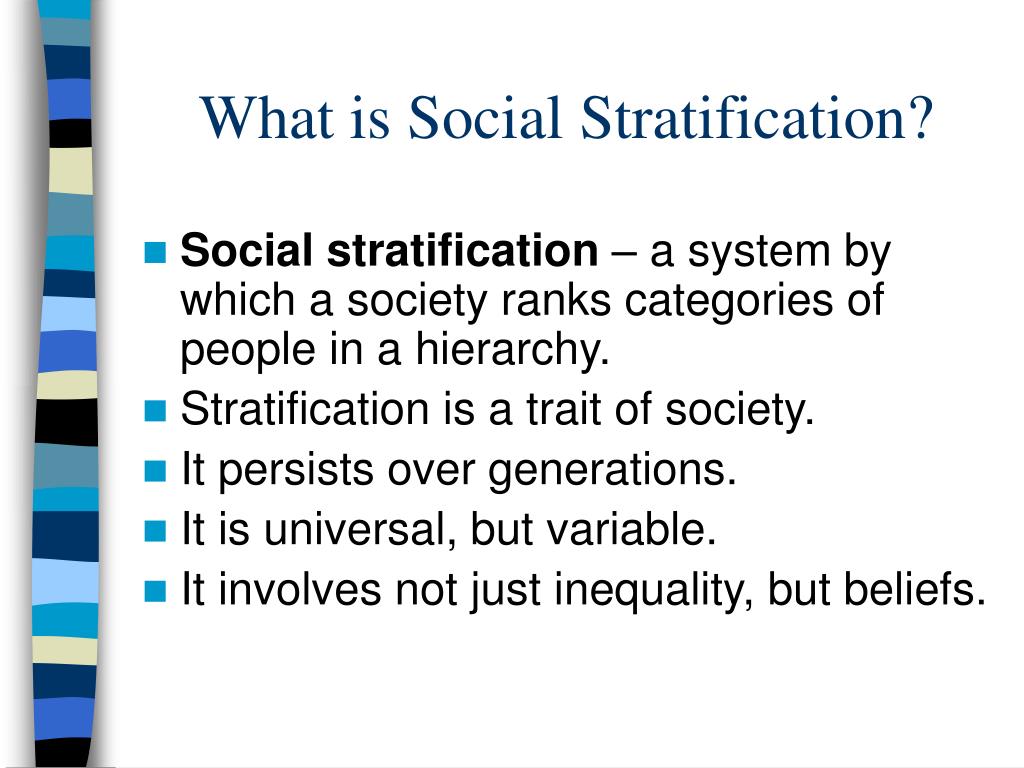Imagine a bustling city, with towering skyscrapers casting long shadows over bustling streets. Some buildings reach for the sky, housing the wealthy and powerful, while others are modest and worn, home to those struggling to make ends meet. This is a microcosm of society itself, where people are arranged in tiers based on factors like wealth, education, and status. This layered structure is what sociologists call stratification, and it’s a fundamental aspect of understanding how our world works.

Image: talisman-intl.com
Stratification sociology explores the inequalities that exist within societies and the systems that create and maintain them. It’s not just about money, but about how these systems shape opportunities, access, and even power dynamics. To truly grasp the complexities of our world, we need to dive deep into the fascinating and often controversial world of stratification sociology.
The Building Blocks of Stratification
Stratification is essentially a hierarchical system where individuals and groups are ranked based on their social position. This ranking can be based on various factors including:
- Wealth: This is a major driver of stratification, determining access to resources, education, healthcare, and even political influence.
- Status: This relates to social prestige and respect, which can be derived from occupation, education, or even family lineage.
- Power: This refers to the ability to influence others or control resources, often stemming from wealth, status, or political positions.
These factors are interconnected, forming a complex web of social inequality. For example, someone with a prestigious job (high status) might also have a high level of wealth and influence (power).
The History of Social Stratification
Understanding stratification requires delving into its historical roots. Social inequality has existed for centuries, with various forms of stratification dominating different societies.
- Ancient Civilizations: In ancient Egypt, for example, society was rigidly stratified into classes, with Pharaohs at the top and slaves at the bottom.
- Feudal Europe: During the Middle Ages, the feudal system in Europe dictated social order based on land ownership and lineage, with nobility ruling over serfs.
- Modern Societies: As societies modernized, new forms of stratification emerged, often based on economic factors like income and class.
While the specific forms have evolved, the fundamental concept of social hierarchy remains a constant throughout history.
Types of Stratification Systems
Sociologists have identified several different types of stratification systems, each with its own unique characteristics:
- Class Systems: These are based primarily on economic factors, such as income, wealth, and occupation. Class systems are fluid, allowing individuals to move between classes through social mobility.
- Caste Systems: These are rigid, closed systems based on birth and ascribe someone to a specific social group (castes) with strict rules governing their interaction. Individuals are locked into their caste, and social mobility is practically nonexistent.
- Estate Systems: These involved a hierarchical system of land ownership and political power, with nobility, clergy, and commoners forming distinct estates. These systems were prevalent in pre-modern Europe.

Image: geteducationbee.com
The Impact of Stratification
Stratification deeply impacts every aspect of our lives, shaping our opportunities, experiences, and even our sense of self. It influences:
- Access to Resources: Individuals with higher social status often have better access to quality healthcare, education, and housing, while those lower down the ladder have fewer opportunities.
- Life Chances: People’s life chances are heavily influenced by their social position. Those born into privilege have a higher chance of success, while those from disadvantaged backgrounds face more obstacles.
- Social Mobility: The ability to move up or down in the social hierarchy varies significantly based on the stratification system and the societal context.
Key Sociological Perspectives on Social Stratification
Different sociological theories offer distinct perspectives on social stratification:
- Functionalist Perspective: This theory argues that stratification is necessary for social stability, as it ensures that the most skilled and talented individuals are rewarded with higher positions.
- Conflict Theory: This theory, often associated with Karl Marx, argues that stratification arises from power struggles between different social groups, and serves to maintain the dominance of the elite.
- Symbolic Interactionism: This perspective focuses on how individuals interact with each other based on their social positions. It explores how social stratification influences our perceptions, behaviors, and identities.
Addressing Social Inequality: Moving Towards a More Just Society
While social stratification is a complex and enduring aspect of society, there’s growing awareness of the need to address the challenges it presents. This includes:
- Promoting Social Mobility: Policies that encourage equal access to education, healthcare, and economic opportunities can promote upward mobility for those from disadvantaged backgrounds.
- Reducing Poverty: Addressing poverty through social programs, job training, and economic policies can break the cycle of disadvantage for individuals and families.
- Fighting Discrimination: Combatting discrimination based on race, ethnicity, gender, or other factors is crucial to creating a more just and equitable society.
What Is Stratification Sociology
The Enduring Impact of Social Stratification
Social stratification, with its intricate layers and complex dynamics, continues to shape our world in many ways. Understanding its historical roots, its different forms, and its impact on our lives is vital to recognizing the challenges and opportunities that lie ahead. By engaging in critical reflection and considering different perspectives, we can work towards building a more just and equitable society for all.






